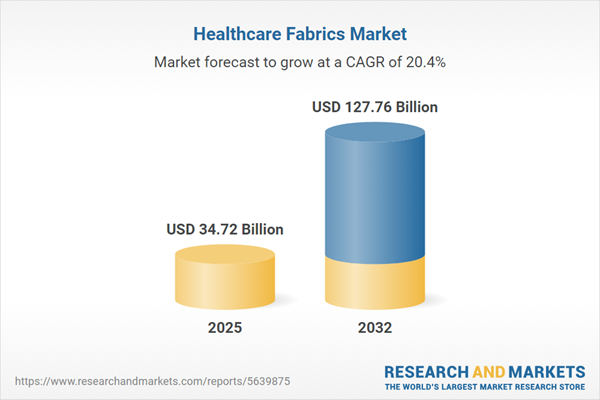Speak directly to the analyst to clarify any post sales queries you may have.
Healthcare procurement is undergoing rapid evolution as organizations adapt to regulatory changes and new sustainability requirements. Senior leaders need insight-driven strategies to navigate the shifting operational priorities and compliance demands within the healthcare fabrics market.
Market Snapshot: Healthcare Fabrics Market Size and Growth Dynamics
The healthcare fabrics market is positioned for strong advancement, with total value forecasted to grow from USD 28.87 billion in 2024 to USD 34.72 billion in 2025, indicating a 20.43% compound annual growth rate. This expansion is being accelerated by increased infection control requirements and rapid integration of specialized textile technologies. Procurement teams now emphasize innovation and compliance as safety and durability become essential criteria. Global sourcing is enabling healthcare organizations to align products with regulatory standards, boost adaptability, and reinforce supply resilience against potential disruptions.
Scope & Segmentation: Optimizing Healthcare Textile Procurement
This report delivers actionable segmentation designed for executive decision-making, enabling tailored procurement planning across the healthcare fabrics market.
- Fabric Types: Nonwoven materials such as meltblown and spunbond offer advantages for infection prevention, while woven fabrics provide benefits in terms of comfort and product longevity.
- Applications: Includes critical uses such as surgical dressings, disposable gowns, masks, and drapes, supporting infection control and operational efficiency in varied care environments.
- Material Types: Evaluates cotton for breathability, polyester and polypropylene for strength, and regenerated cellulose for performance under frequent clinical demands.
- End Users: Analyzes procurement needs of hospitals, clinics, ambulatory centers, and home care providers, reflecting diverse requirements to safeguard both patients and staff.
- Sterilization Methods: Covers compatibility with ethylene oxide, gamma irradiation, and steam sterilization, ensuring product safety and alignment with health standards.
- Distribution Channels: Examines direct sourcing, distributor networks, e-commerce, and pharmacy retail, supporting multiple models of textile acquisition and delivery.
- Geographic Coverage: Addresses regional sourcing and regulatory considerations across North America, South America, Europe, Middle East & Africa, and Asia-Pacific, with a focus on infrastructure and compliance variability.
- Company Coverage: Profiles major sector operators including Kimberly-Clark Corporation, DuPont de Nemours, Berry Global, Ahlstrom-Munksjö, Asahi Kasei, Toray Industries, Avient, Lydall, Glatfelter, and Suominen Corporation, highlighting their roles in standard setting and technology leadership.
Key Takeaways for Senior Decision-Makers
- Agile sourcing strategies are essential to address rapid shifts in supply chains and regulatory frameworks within healthcare procurement.
- Investment in advanced nonwoven fabric processes enables organizations to better achieve infection control and sustainability objectives.
- Collaboration between procurement, clinical stakeholders, and fabric technologists drives the creation of fit-for-purpose textile solutions targeted to the specific needs of each care environment.
- Sustainability initiatives, such as prioritizing circular supply strategies, are fundamental to minimizing environmental impact and improving resource efficiency in healthcare textiles.
- Adoption of track-and-trace systems increases transparency and strengthens risk management across procurement channels.
- Customizing procurement approaches by region empowers organizations to overcome regulatory complexity and sustain operational continuity.
Tariff Impact: United States Tariffs and Sourcing Strategies
With new tariffs on medical textiles anticipated in the United States in 2025, procurement leaders are expanding supplier bases in Asia-Pacific and Latin America. This diversification reduces exposure to regulatory and pricing volatility, bolstering the stability of textile supplies throughout changing market conditions.
Methodology & Data Sources
Analyses are based on direct interviews with procurement experts, input from technical specialists, and ongoing regulatory review. Comprehensive validation includes documentation checks and patent research, ensuring findings are robust for procurement decision-making.
Why This Report Matters
- Supports executive teams in aligning compliance, sourcing, and risk strategies with today’s healthcare procurement environment.
- Clarifies the impact of technology advances and diversified sourcing for improved supply continuity and adaptability.
- Offers segmented, practical insights critical for resilient procurement and targeted investment decisions in the healthcare fabrics sector.
Conclusion
This report equips senior leaders with clear, evidence-based guidance for future-focused procurement, strengthening organizational resilience as healthcare fabrics markets further develop.
Additional Product Information:
- Purchase of this report includes 1 year online access with quarterly updates.
- This report can be updated on request. Please contact our Customer Experience team using the Ask a Question widget on our website.
Table of Contents
3. Executive Summary
4. Market Overview
7. Cumulative Impact of Artificial Intelligence 2025
Companies Mentioned
The companies profiled in this Healthcare Fabrics market report include:- Kimberly-Clark Corporation
- DuPont de Nemours, Inc.
- Berry Global Group, Inc.
- Ahlstrom-Munksjö Oyj
- Asahi Kasei Corporation
- Toray Industries, Inc.
- Avient Corporation
- Lydall, Inc.
- Glatfelter Corporation
- Suominen Corporation
Table Information
| Report Attribute | Details |
|---|---|
| No. of Pages | 189 |
| Published | October 2025 |
| Forecast Period | 2025 - 2032 |
| Estimated Market Value ( USD | $ 34.72 Billion |
| Forecasted Market Value ( USD | $ 127.76 Billion |
| Compound Annual Growth Rate | 20.4% |
| Regions Covered | Global |
| No. of Companies Mentioned | 11 |









